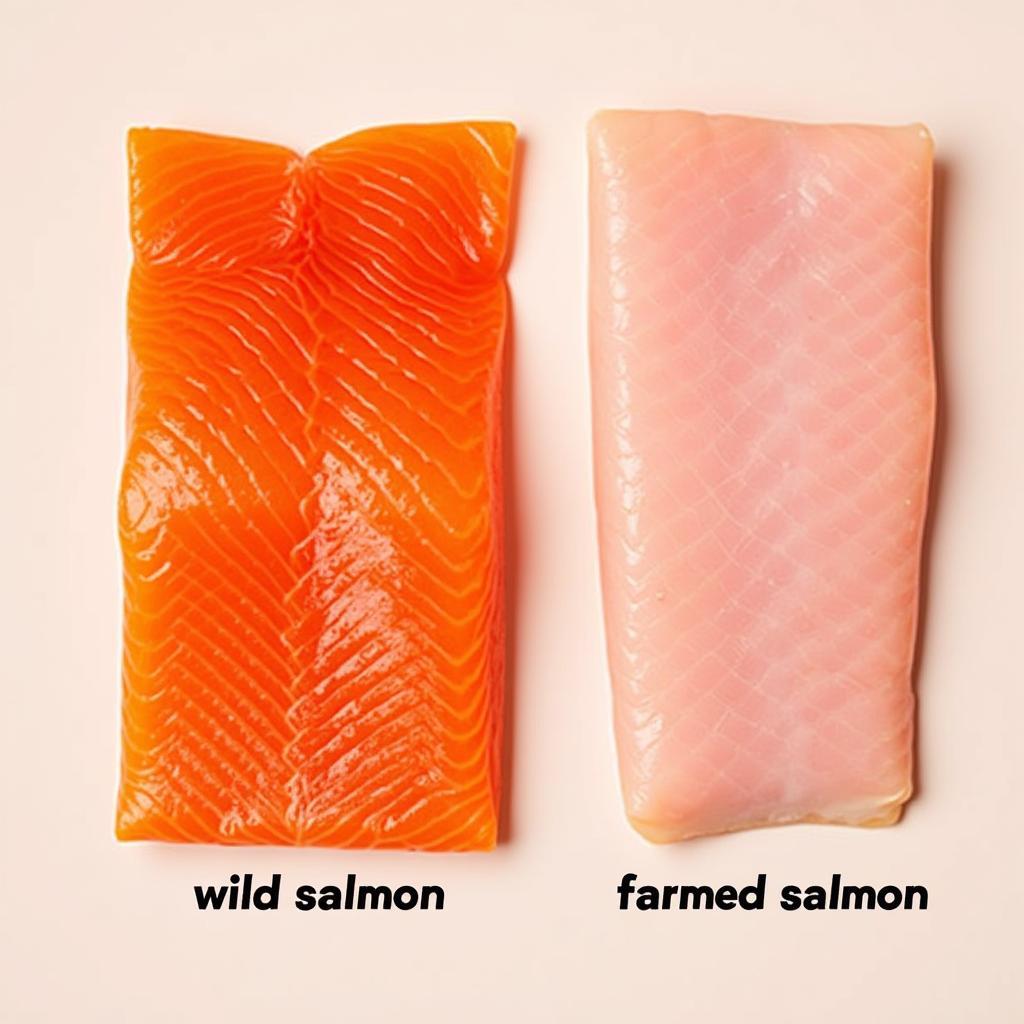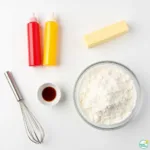Salmon’s distinct orange-pink hue is a fascinating subject, often sparking curiosity. It’s not just a random color; there’s a specific reason behind this iconic shade. We’ll delve into the science, explore the nuances of salmon coloration, and discover why not all salmon share the same vibrant tint.
 Wild vs. Farmed Salmon Color Comparison
Wild vs. Farmed Salmon Color Comparison
The Science Behind Salmon’s Orange Color
The secret to salmon’s orange color lies in their diet. Wild salmon consume small crustaceans like krill and shrimp, which are rich in carotenoids, particularly astaxanthin. This naturally occurring pigment is what gives these creatures, and consequently the salmon that eat them, their reddish-orange hue. It’s the same pigment that makes flamingos pink, further highlighting nature’s interconnectedness. Are you curious about why flamingos lose their vibrant color? Learn more about do flamingos lose their pink color.
Carotenoids and Astaxanthin: Nature’s Paintbrush
Carotenoids are a group of pigments found in plants and algae. They play a vital role in various biological processes, including photosynthesis and antioxidant protection. Astaxanthin, a type of carotenoid, is particularly potent and is known for its vibrant color and health benefits. It’s this astaxanthin that gets stored in the salmon’s flesh, giving it that characteristic orange-pink color.
Why Isn’t All Salmon the Same Color?
While wild salmon typically exhibit a vibrant orange-pink color, farmed salmon can sometimes appear paler or even have a slightly grayish tinge. This difference primarily stems from their diet. Farmed salmon are often fed a diet that lacks the same abundance of astaxanthin found in the wild. To compensate, farmers sometimes add synthetic astaxanthin to the feed, attempting to replicate the natural color. However, achieving the same depth and vibrancy as wild salmon can be challenging. Just like the question of why salmon is orange in color, you might also wonder about the color of a cantaloupe. Learn more at what color is cantaloupe.
 Salmon Diet: Krill and Shrimp
Salmon Diet: Krill and Shrimp
Wild Salmon vs. Farmed Salmon: A Color Comparison
The color difference between wild and farmed salmon is a telling sign of their respective diets and lifestyles. Wild salmon, with their access to a natural diet rich in astaxanthin, boast a deep, rich orange hue. In contrast, farmed salmon, often raised on a controlled diet, may display a paler pink color, sometimes even bordering on gray. The vibrant hues of certain fish can be truly mesmerizing. Ever wondered about fish with rainbow colors? Explore the vibrant world of what type of fish has a rainbow color.
The Role of Genetics and Other Factors
While diet is the primary determinant of salmon color, genetics and other environmental factors also play a role. Certain species of salmon naturally have a lighter or darker base coloration, which can influence the final appearance. Water temperature, salinity, and even stress levels can also affect the intensity of the orange pigment.
Expert Insights: Dr. Emily Carter, Marine Biologist
“The color of salmon is a remarkable example of how diet directly impacts an organism’s physical appearance,” explains Dr. Emily Carter, a renowned marine biologist. “The vibrant orange color we associate with salmon is a testament to the power of natural pigments like astaxanthin.”
Expert Insights: Chef Michael Dubois, Seafood Specialist
“As a chef, I appreciate the rich color and flavor of wild salmon,” shares Chef Michael Dubois, a seafood specialist. “The deep orange hue is a visual indicator of its superior quality and nutritional value.” Have you ever wondered why is salmon pink in color?
Conclusion
The orange color of salmon is a direct result of their diet, specifically their consumption of astaxanthin-rich crustaceans. While variations in color can occur due to farming practices, genetics, and other environmental factors, the vibrant orange-pink hue remains a hallmark of this iconic fish. Understanding why salmon is orange in color allows us to appreciate the intricate connections within the natural world and the impact of diet on an organism’s characteristics. It also provides valuable insights into the differences between wild and farmed salmon.
FAQ
- Why are some salmon pinker than others? The intensity of the pink color depends primarily on the amount of astaxanthin in their diet.
- Is the color of salmon an indicator of its health? A vibrant color can suggest a healthy diet rich in astaxanthin, but other factors also contribute to overall health.
- Can farmed salmon achieve the same color as wild salmon? While farmers can supplement feed with astaxanthin, replicating the exact color and nutritional profile of wild salmon is challenging.
- Do different species of salmon have different colors? Yes, genetics plays a role in base coloration, which can influence the final hue.
- What other animals get their color from astaxanthin? Flamingos, lobsters, and some types of shrimp also derive their color from this pigment. Some colors are truly unique and distinctive. Have you ever wondered about Itadori’s hair color? You can find the answer at what color is itadori's hair.
- What are the health benefits of astaxanthin? Astaxanthin is a powerful antioxidant with potential benefits for eye health, skin health, and cardiovascular health.
- Is it safe to eat farmed salmon with added astaxanthin? Regulatory bodies generally consider the use of astaxanthin in salmon feed to be safe.
Need support? Contact us at Phone Number: 0373298888, Email: [email protected] Or visit us at 86 Cau Giay, Hanoi. We have a 24/7 customer service team.

